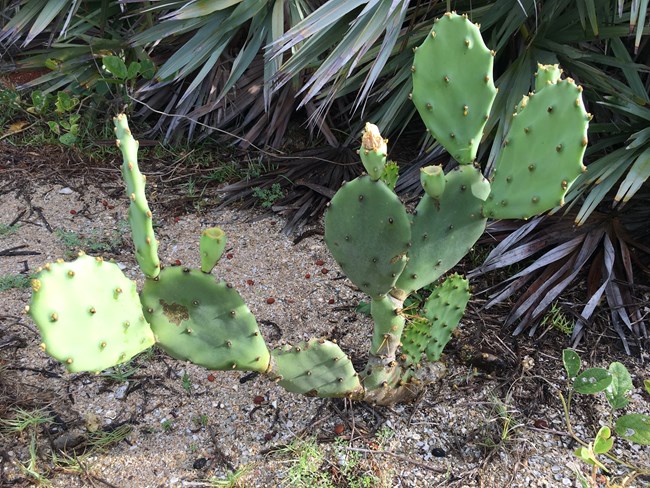|
Canaveral National Seashore is a utopia for botanists. Over 1,000 species of plants have been recorded in the park and surrounding area. Because of its location along the "frost line", Canaveral contains a unique combination of temperate and subtropical plants. Several temperate species extend no farther south than Canaveral National Seashore, while a number of subtropical species occur no farther north. Signs of this unusual mixture include the hammocks, which contain an overstory dominated by temperate species and an understory comprised of subtropical plants. Another sign is the significant shift in vegetation along the edge of the lagoon from salt marsh cordgrass (Spartina alterniflora), which predominates in coastal areas north of the park, to mangrove species which predominant to the south. 
Sand DunesDunes are the backbone of a barrier island, providing stability in a constantly shifting environment. While some beaches have several parallel dune ridges, Canaveral National Seashore only has one. This dune intercepts the wave action, wind abrasion, and salt spray, sheltering the plant communities which lie inland and protecting the mainland from flooding and erosion. The dune also provides valuable habitat for a number of protected species, including the southeastern beach mouse, eastern indigo snake, and gopher tortoise (More can be learned about these unique species under Animals/Mammals and Reptiles). Canaveral's dune tends to be steep on the ocean side and gradually sloped on the landward side. Plants growing on the dune play a critical role in anchoring the sand. Canaveral is very fortunate in this aspect. Botanists rave about the dense growth of plants, particularly on the landward or back side of the dune. Common species growing on the front part of the dune include railroad vine (Ipomoea pes-caprae), seaside bean (Canavalia rosea), beach morning glory (Ipomoea imperati), beach elder (Iva imbricata) and sea oats (Uniola paniculata). Sea oats plays a particularly vital role in anchoring the dune. Adapted to the dynamic environment, it is actually stimulated to grow when buried in sand and sends an extensive network of roots deep into the sand. Because of this, it is illegal to pick sea oats in Florida. Common plants along the backside of the dune include sea grape (Coccoloba uvifera), prickly pear cactus (Opuntia sp.) and saw palmetto (Serenoa repens). Sea grape is very distinctive because of the large, oval, leathery leaves and, in season, by the large clusters of grape-like fruits, which make excellent jelly. Dune plant communities are very fragile. Repeatedly walking across a dune can damage the vegetation and open the way for accelerated erosion. To protect the dune from foot traffic by over one million visitors a year, the park has constructed boardwalks from its 18 parking areas to the beach. The park is known for its boardwalks; managers from other beaches visit to examine their design. The park has also taken several steps to restore overwashed and eroded dune areas, including installation of dune fencing to catch blowing sand and planting native vegetation to anchor accumulating sand. |
Last updated: December 12, 2017

